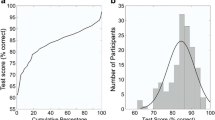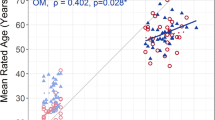Abstract
The results of two experiments are presented which explore the effect of distractor items on face and voice recognition. Following from the suggestion that voice processing is relatively weak compared to face processing, it was anticipated that voice recognition would be more affected by the presentation of distractor items between study and test compared to face recognition. Using a sequential matching task with a fixed interval between study and test that either incorporated distractor items or did not, the results supported our prediction. Face recognition remained strong irrespective of the number of distractor items between study and test. In contrast, voice recognition was significantly impaired by the presence of distractor items regardless of their number (Experiment 1). This pattern remained whether distractor items were highly similar to the targets or not (Experiment 2). These results offer support for the proposal that voice processing is a relatively vulnerable method of identification.
Similar content being viewed by others
Notes
Analysis in signal detection terms enables scrutiny of both sensitivity of discrimination (d’) and bias (C). Analysis of bias here revealed no effects either of the number of intervening stimuli (F (2, 76) < 1, ns), stimulus type (F (1, 38) < 1, ns) or their interaction (F (2, 76) < 1, ns).
As in Experiment 1, analysis of bias is included here to explore the effect of stimulus type, distraction and distractor strength on responding. Only one interaction emerged as a weak effect (distraction x stimulus type: F (2, 122) = 3.23, p < .05, ή2 = .05). However, there was no effect of distraction on bias for faces (F (2, 64) = 1.17, ns) or voices (F (2, 62) = 2.53, ns), and there was no significant difference in levels of bias between faces and voices at either zero distractors (t (63) = −1.53, ns), two distractors (t (63) = 1.20, ns) or four distractors (t (63) = −1.61, ns). This interaction instead seemed to capture a reversal of small levels of bias between faces and voices when there were two distractors. No other main effects of interactions reached significance (Fs < 1.38, ns).
References
Bahrick, H. P., Bahrick, O. O., & Wittlenger, R. P. (1975). Fifty years of memory for names and faces: A cross-sectional approach. Journal of Experimental Psychology General, 104, 54–75.
Barsics, C., & Brédart, S. (2011). Recalling episodic information about personally known faces and voices. Consciousness and Cognition, 20(2), 303–308.
Barsics, C., & Brédart, S. (2012). Recalling semantic information about newly learned faces and voices. Memory, 20(5), 527–534.
Brédart, S., Barsics, C., & Hanley, R. (2009). Recalling semantic information about personally known faces and voices. European Journal of Cognitive Psychology, 21, 1013–1021.
Burton, A. M., Bruce, V., & Johnston, R. A. (1990). Understanding face recognition with an interactive activation model. British Journal of Psychology, 81, 361–380.
Clifford, B. R. (1980). Voice identification by human listeners: On earwitness reliability. Law and Human Behavior, 4(4), 373–394.
Cook, S., & Wilding, J. (1997). Earwitness Testimony 2: Voices, Faces and Context. Applied Cognitive Psychology, 11, 527–541.
Damjanovic, L. (2011). The face advantage in recalling episodic information: Implications for modelling human memory. Consciousness and Cognition, 20(2), 309–311.
Damjanovic, L., & Hanley, J. R. (2007). Recalling episodic and semantic information about famous faces and voices. Memory and Cognition, 35, 1205–1210.
Ellis, H. D., Jones, D. M., & Mosdell, N. (1997). Intra- and inter-modal repetition priming of familiar faces and voices. British Journal of Psychology, 88, 143–156.
Hanley, J. R., & Damjanovic, L. (2009). It is more difficult to retrieve a familiar person’s name and occupation from their voice than from their blurred face. Memory, 17, 830–839.
Hanley, J. R., Smith, S. T., & Hadfield, J. (1998). I recognise you but can’t place you. An investigation of familiar-only experiences during tests of voice and face recognition. Quarterly Journal of Experimental Psychology, 51A(1), 179–195.
Hanley, J. R., & Turner, J. M. (2000). Why are familiar-only experiences more frequent for voices than for faces? Quarterly Journal of Experimental Psychology, 53A, 1105–1116.
Hinz, T., & Pezdek, K. (2001). The effect of exposure to multiple lineups on face identification accuracy. Law and Human Behavior, 25, 185–198.
Kerstholt, J. H., Jansen, N. H. M., van Amelsvoort, A. G., & Broeders, A. P. A. (2006). Earwitnesses: Effects of accent, retention and telephone. Applied Cognitive Psychology, 20, 187–197.
McAllister, H. A., Dale, R. H. I., Bregman, N. J., McCabe, A., & Cotton, C. R. (1993). When eyewitnesses are also earwitnesses: Effects on visual and voice identifications. Basic and Applied Social Psychology, 14(2), 161–170.
McGehee, F. (1937). The reliability of the identification of the human voice. Journal of General Psychology, 17, 249–271.
Saslove, H., & Yarmey, A. D. (1980). Long-term auditory memory: Speaker identification. Journal of Applied Psychology, 65, 111–116.
Schweinberger, S. R., Herholz, A., & Stief, V. (1997). Auditory long-term memory: Repetition priming of voice recognition. Quarterly Journal of Experimental Psychology, 50A(3), 498–517.
Stevenage, S. V., Howland, A., & Tippelt, A. (2011). Interference in eyewitness and earwitness recognition. Applied Cognitive Psychology, 25(1), 112–118.
Stevenage, S. V., Hugill, A. R., & Lewis, H. G. (2012). Integrating voice recognition into models of person perception. Journal of Cognitive Psychology (in press).
Yarmey, A. D. (1995). Earwitness speaker identification. Psychology, Public Policy and Law, 1(4), 792–816.
Author information
Authors and Affiliations
Corresponding author
Rights and permissions
About this article
Cite this article
Stevenage, S.V., Neil, G.J., Barlow, J. et al. The effect of distraction on face and voice recognition. Psychological Research 77, 167–175 (2013). https://doi.org/10.1007/s00426-012-0450-z
Received:
Accepted:
Published:
Issue Date:
DOI: https://doi.org/10.1007/s00426-012-0450-z




